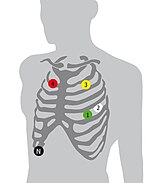Cardiogoniometry
The Cardiogoniometry also Cardiogoniometry (CGM), provides a method for stress-free ischemia represents.
The procedure itself is based on the spatio-temporal evaluation of electrocardiographic data and was developed by the Swiss cardiologist Sanz.
Depending on the anatomical position of the heart, five electrodes are placed on the patient. The special feature of this system is that all electrodes have a defined distance from one another, corresponding to the patient's chest height, and the axes are already aligned perpendicular to one another. A three-dimensional recording of the spread of electrical excitation in the heart can be made in twelve seconds. The patient will not like B. burdened with ergometry . The examination is carried out lying down, at rest and, if possible, with breathing cessation (after exhaling). Several hundred parameters are determined during an exposure, which are then used to assess the myocardial mass and the blood supply to the myocardium. In addition to the analysis of these various parameters, the data is also graphically evaluated by means of a spatial representation of the potentials in the form of "loops", similar to vector cardiography .
It is known from the EKG that the QRS complex can be assigned to the depolarization and the area of the T wave to the repolarization of the ventricle. An oxygen deficiency during repolarization shows corresponding changes in the T-loop. In this way, signs of existing myocardial ischemia can be recognized at an early stage through changes in the repolarization phase. Similarly, myocardial damage can be diagnosed by changing the depolarization phase.

